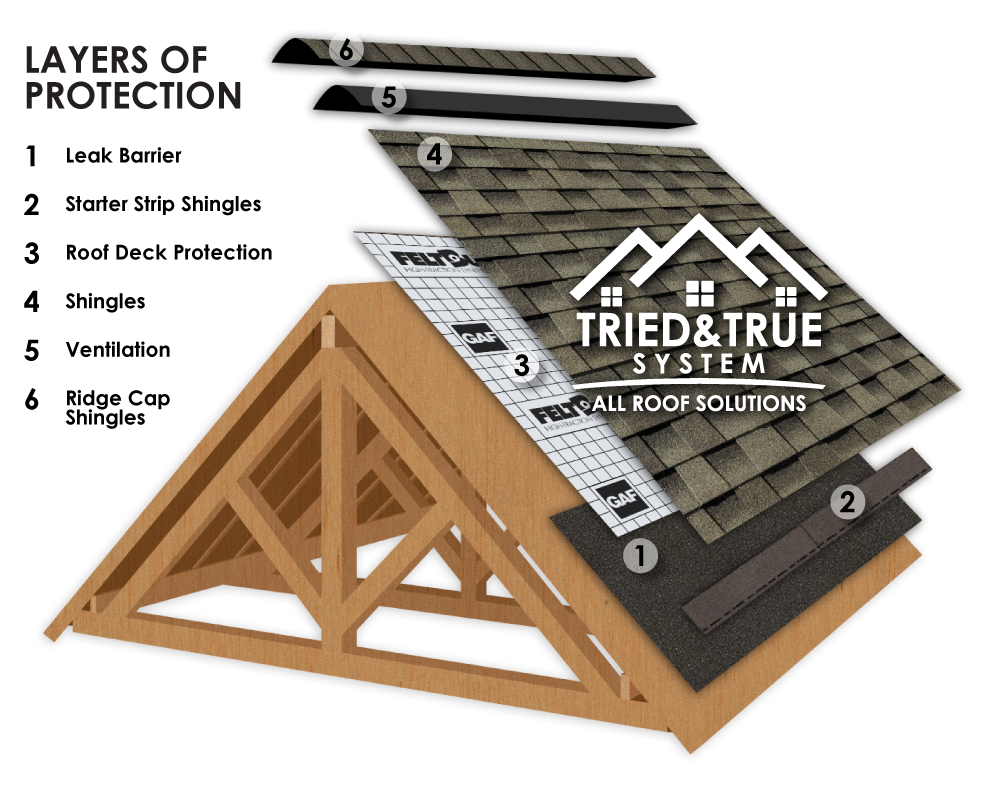At a glance from an untrained eye, roofs look like a pile of shingles covering the top of a house, but that's only part of the equation here. There are layers of a roof that create layers of protection. Done right, you'll never need to know what all these layers are. But if your roof is facing an issue, it's important to know what each layer of your roof does to protect your home.

Framing
The first layer of any roof is the framing. This is what gives the roof its shape and is the foundation for the rest of the materials. The framing is made up of trusses that support the weight of all the roofing materials-- their triangular shape helps support and distribute the weight.
Insulation
Technically not on your roof but underneath it in the attic is a layer of insulation. The insulation helps minimize heat loss in your home and protects the various layers of your roof from extreme temperatures that can damage and break down the materials.
Ventilation
Also, in the attic, ventilation gives hot, moist air somewhere to escape to instead of staying trapped underneath your roof. Improper ventilation can lead to mold and damage to your roofing frame and deck.
Roof Deck
Directly on top of the framing is the roof deck. Commonly made up of sheets of plywood, the roof deck connects the trusses and joints of the framing together and provides a solid surface to layer the rest of the roof onto.
Water Barrier
With the roof deck and frame made out of wood, there needs to be a layer of protection from water. The water barrier is an adhesive layer applied to the roof deck to protect against water infiltration from melting ice and wind-driven rain.
Underlayment
The main purpose of the underlayment is to serve as an additional layer of protection between the shingles and the roof deck. It creates a flatter, more uniform surface for the shingles to adhere to and helps reduce blow off.
Starter Strip
A starting layer of shingles lines the edge of every home's roof. The starter strip is laid down underneath the underlayment to seal the edges of the roof. The purpose of this layer is to defend the rest of the roof against strong winds and reduce blow off.
Shingles
The most obvious layer of protection on your roof is the layer of shingles. Your shingles protect your home against sun, water, and other various weather conditions. The granules on shingles are made up of fiberglass that provide form and function-- the fiberglass determines the look of the shingles but it also protects it against fire damage.
Ridge Cap
This is a special type of shingle that runs along the ridge line of a sloped roof. It's installed over the joint of two edges to keep out rain and snow, but it also allows heat and moisture to escape from the attic.
Flashing
Flashing isn't a full layer of a roof, but it does add necessary protection. Flashing is made out of sheet metal and is installed over sections of the roof where seams are present-- where the roof meets the chimney, for example. It's there to keep water from penetrating your roof and causing damage.
The Layers of a Roof are Layers of Protection
Roofs are more intricate than they look. Because of this, it's crucial that you be specific about who you trust to inspect, repair, and install your roof. Every layer of a roof holds a significance and cannot be overlooked. If you haven't had your roof inspected this year, our All Roof team is available as a resource to you. Be sure each layer of protection is doing its job well before it's too late.
